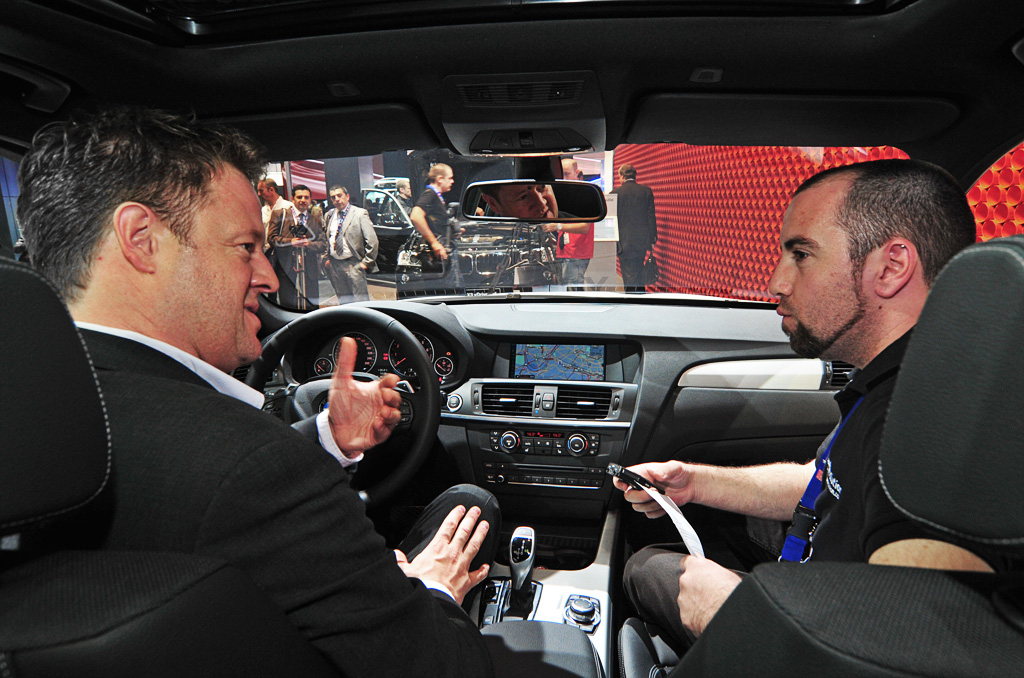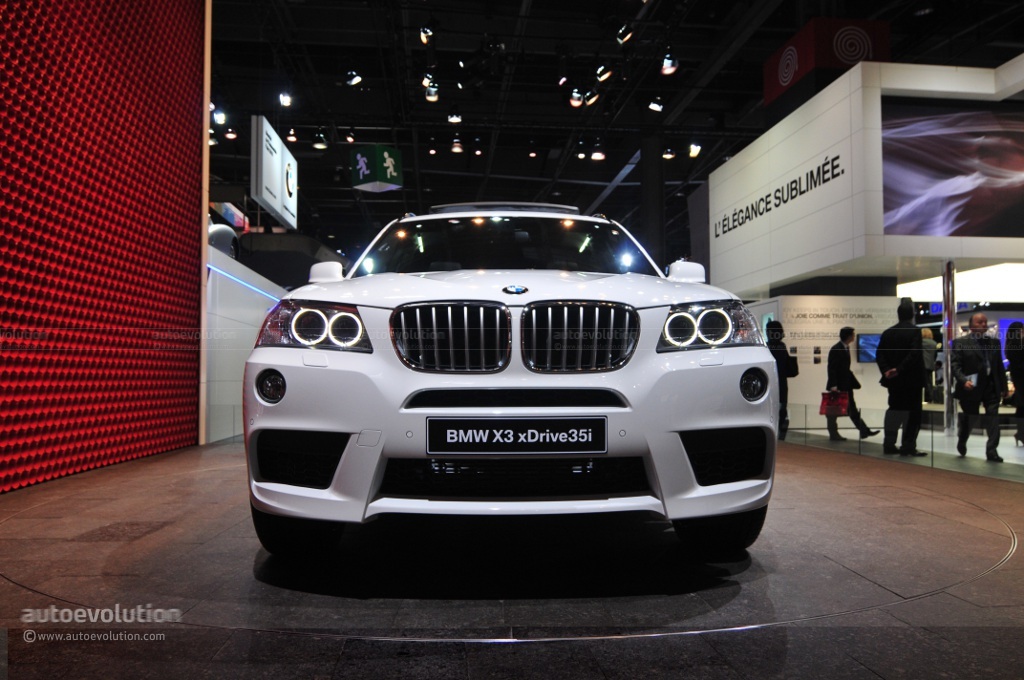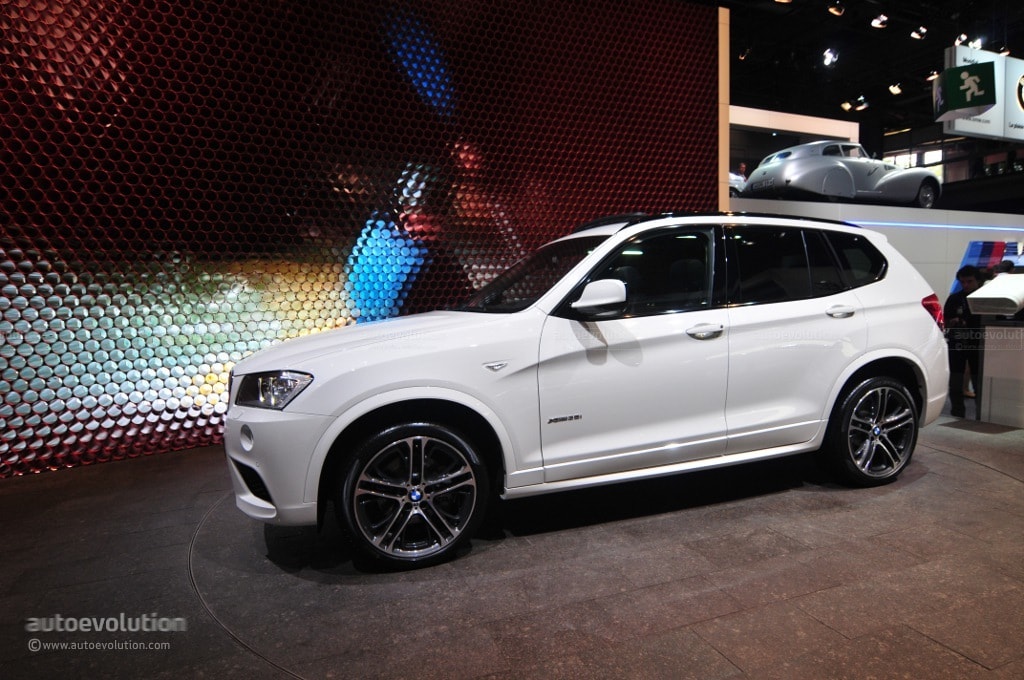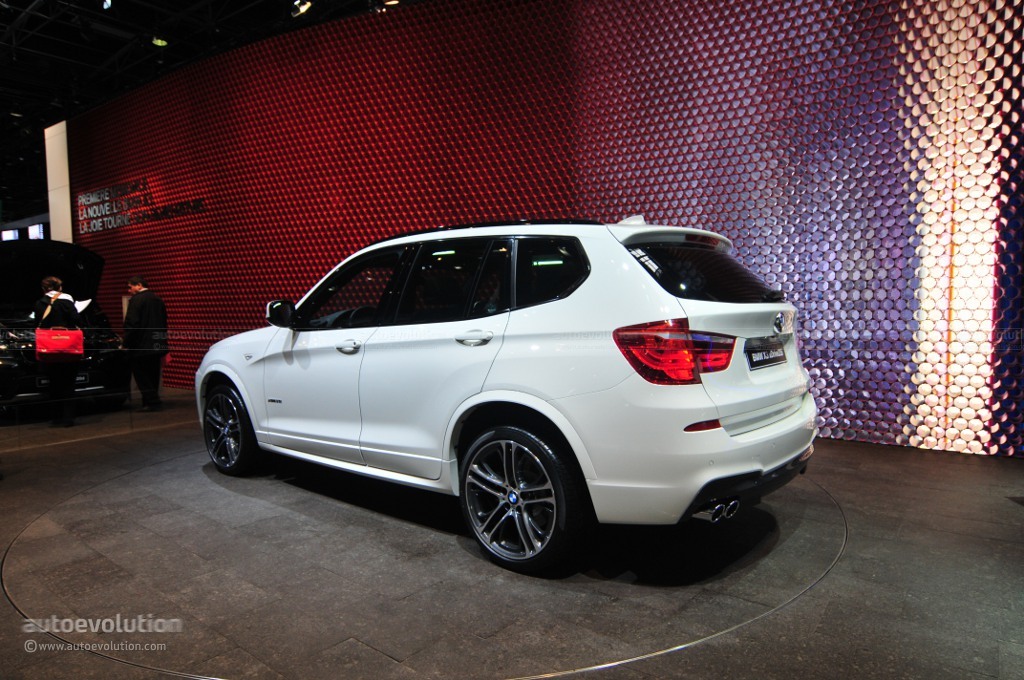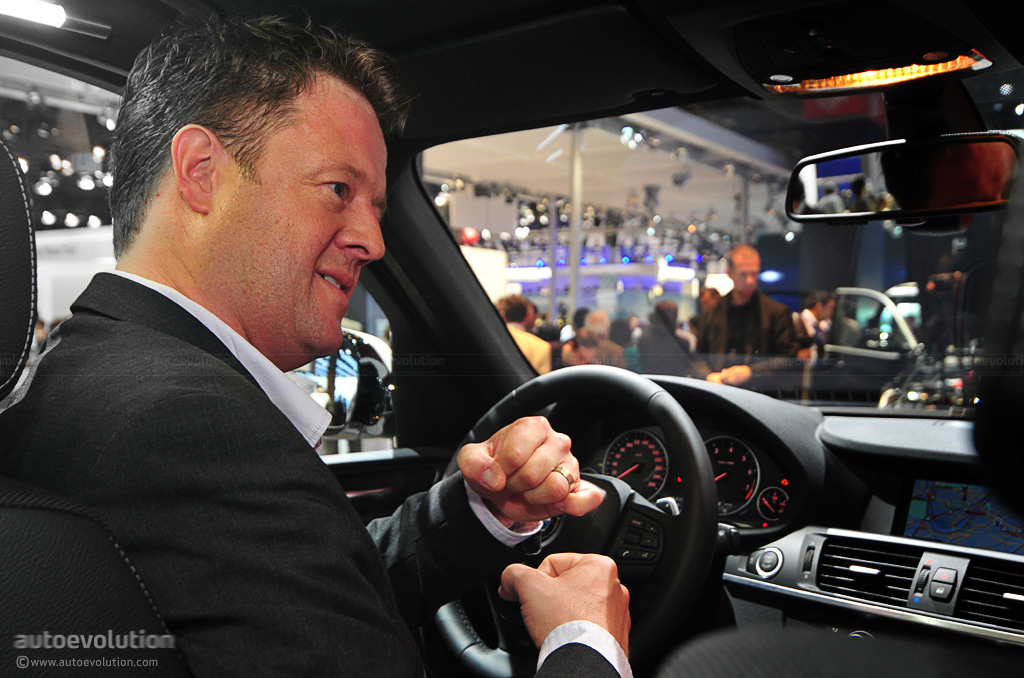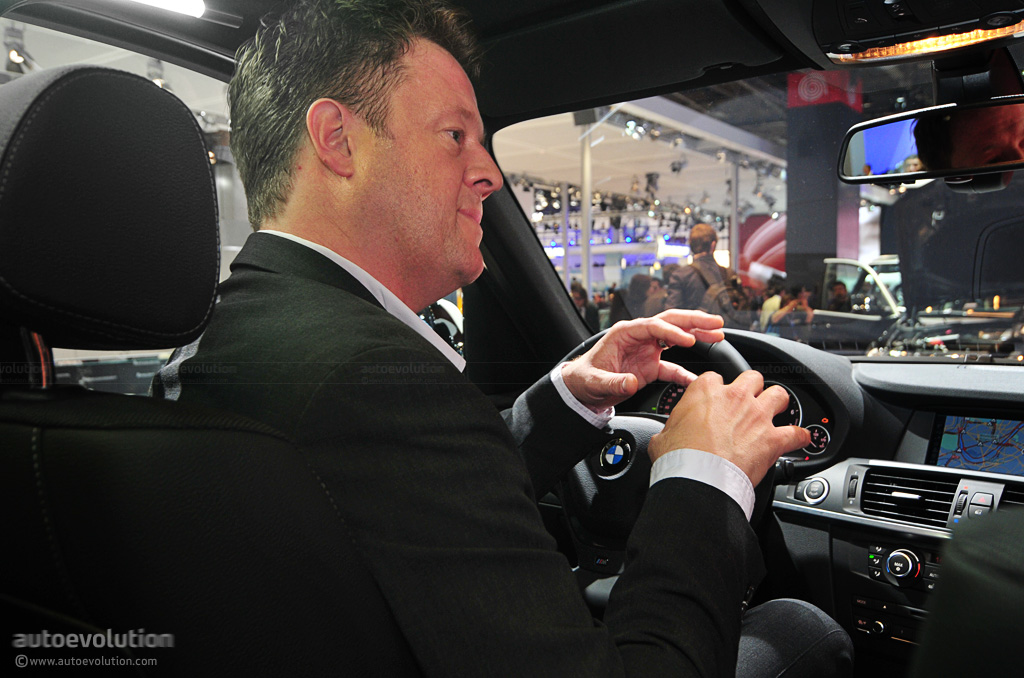During our 2010 Paris Auto Show visit we had the chance to have an exclusive interview with BMW's Erik Goplen, the man behind the exterior design of the F25 X3 and the much-acclaimed E46 3-Series. What first started as a regular auto show interview transformed into a very casual talk without the marketing gibberish we were expecting:
Alex Oagana: The F25 X3 is not your first BMW road car design, since you were also in charge of penning the E46 3-Series. Both the 3-Series and the X3 are totally different cars, for completely different people. Which of the two models proved to be the bigger challenge design-wise?
Erik Goplen: I think there were very different challenges with the two cars. The 3 Series E46 really tried to bring back some of the strength of past BMWs – with the L-shaped tail lamps, for example. I think for me, my goals have always been first with proportion, so the car has to sit right on the wheels.
Every BMW has to have this really good stance, so with the E46 I tried to do that. Definitely the challenge was here in the beginning [with the F25 X3]. We did not have the same simplicity, like with the Coupe for example [the E46]. In this case, we kind of worked together with Adrian (van Hooydonk, ed) and the development team and we managed to get the track wider in the process...
Alex Oagana: So there were more technical difficulties?
Erik Goplen: Yeah, technical difficulties, but then that gave us the chance really to make the car really bold and strong on its feet, let's say around the wheels. You can see that in the sculpture of the car, I really tried to make a strong sculpture around the wheel openings, both front and rear, and in this case with the dynamics of the character line. So my love is always first proportion and then the surface, trying to create this really muscular form.
I think you can see, in some ways, maybe a little bit of similarity from the front quarter view and side with the E46. Both the E46 3-Series and the F25 X3 have a rather similar stance if you look closely. This comes a little bit from the spirit of our development team and also our the clay modeler, whom I worked with on both cars actually.
Alex Oagana: So you've pretty much kept the same team working on the new X3?
Erik Goplen: Umm... no, the teams are an old, separate story[...] But just the development of form was rather similar. So, again, back to your question, the challenge was possibly greater with this car [the F25 X3]. We had an X3 that was kind of trying to be the little brother and find its way with the X5. But now we have the X1, so in this case I wanted to make the new car more... umm...
Alex Oagana: More mature?
Erik Goplen: More mature, yeah, but also a bit more... let's say exciting with the X DNA. So that was something that I really believed in right from the start of the project.
Alex Oagana: You've mentioned in other interviews that BMW has a design heritage which it has to maintain. Considering that the X3 is now only at its second generation, what kind of details which could pass as "design heritage" did it have to maintain from both BMW's design history and from its first generation (the E83, ed)?
Erik Goplen: Well, the things I believe were the strong points of the previous generation are the kick up belt line, which I thought was really dynamic. On the previous model it was a bit more horizontal, so we gave it a little more wedge. Also - bringing back the L-shaped lamps on the E46 – I wanted to keep the T-shaped lamps of the previous X3, but make them stronger with the arrow edge and integrate them more beautifully into the back of the car.
So those are probably the two visible links between the two generations. Other than that, I tried to take the car and bring it to a whole new level of maturity and sophistication. I also tried to keep the front and rear overhangs as minimal as possible , thus offering a very agile appearance. The previous model did not have that in the same way.
That's actually another thing in which I believe very much as far as BMW design traits go. Simply not wasting any space. Some of our competitors have really long front overhangs, which in my opinion take away some of the tension of the overall lines (I have a hunch he was talking about Audi here, ed).
Alex Oagana: Did you have certain guidelines, or should we say principles - self-imposed or not - to follow when penning the main lines/details for the car? For example, did the new generation of the X3 have to look a certain way or express certain emotions, or where you completely free to go into any design direction?
Erik Goplen: No, not really. That's an interesting question actually, because in the beginning we already knew that the X1 was going to come, so we really wanted to make the new X3 a little more spacious and a bit more confident. I think that was probably the only "guideline", as you say – just bringing more confidence across the design.
When it comes to a family relationship [...] it's really taking from the first sketch – I don't know if we released the sketches yet, but I hope my artwork made at Designworks can be seen seen soon [...] So, to answer your question, I think the guidelines were built from the initial spirit of the sketches, but there was no brief that we had to necessarily follow, which is good. BMW is usually pretty free with that, we try a lot of designs and then we pick the best ones together with Adrian (van Hooydonk, ed) and the board.
Alex Oagana: While at BMW, you've penned both a sedan and a crossover/SAV. What is the type of car that you appreciated more to design?
Erik Goplen: Well, that actually has two different meanings for me. When I did the E46 sedan, the convertible and the coupe I was a little bit more free in my personal life and a little more focused on driving – I've done some performance driving courses and so on - and I am definitely still passionate about that. When I started doing the X3 it was totally different, I was married and so on [...] my wife came over to me and actually, while we were developing the car we found out that we were pregnant with our first son...
Alex Oagana: Congratulations!
Erik Goplen: Thank you! So I think there is a bit more of a personal story/connection, so I was very happy to see the car get a little more functionality to it. So from my side I think the X3 means the best of both worlds. It has the sporty driving characteristics – which I love and I believe in – and, on the other hand, it has a bit more of a practical touch to it. We have to put strollers in, and having an active family I want to be able to put a mountain bike in, etc. so I guess I'm actually like the perfect link to this car.
Alex Oagana: From your background - and this discussion also, actually - I understand that you're quite an old-school petrolhead/car collector and that you even own a 1969 De Tomaso Mangusta, which was designed by Giugiaro. What is your favorite automobile designer in history, if you have one?
Erik Goplen: Of course, Giugiaro has been an inspiration. His talent to go in many different areas of car design are very well seen – I think he's probably one of the most prolific designers in the world. And then there are of course a lot of friends and colleagues that I've worked with and I have a lot of appreciation for their designs. But when it comes to versatility [...] for example what I like about the Mangusta is the purity of its design, its Italian heritage.
A fact that I think is somewhat less known is that I started the E46 in Italy. I was working in Turin, because Chris Bangle had his roots with Fiat there (he designed the notorious Fiat Coupe, ed) so I had the chance to work with the Italian outside modeling team and do the car in apple wood and other old Italian processes.
There is a story that Gandini was there before me, doing the Diablo, and he used a curve on a spline that consequently used on a mirror – the original mirror – of probably one of my favorite cars. So I actually used that curve - I got it from one of the guys – to do the hood of the E46. So myself and Chris Chapman – who did the original X5 E53 – made a copy of this curve and called it "Excalibur", because it looks like a sword. (laughs)
I really like the beautiful mystique about this story, you know – because there's some curve that matches these two cars [...] and this is also part of my fascination with the Mangusta. It has the purity and proportions of Italian design and then there's the power and the confidence of the American V8 in it. It's probably a mixture of my personality as well.(smiles)
Alex Oagana: I see. So, on a somewhat related note, would you have liked to design a concept car, or perhaps a future M1?
Erik Goplen: Oh definitely! I've actually done several proposals with my team - because currently I run the Advance Design operations for Designworks USA – and we are involved in every project pretty well. So I've done some sketches and original concept ideas for the Vision EfficientDynamics. Mario (Mario Majdandzic - Vision ED exterior designer, ed) did a great job in the end. I had some similar, yet very different ideas for the concept, and I hope to become involved more in these future projects.
Also to be able to show you guys, because we have a lot of stuff we do many times and we don't show it. We just wait and se what's up. So it's pretty strategic but there are pretty exiting times for us right now. We're one of the few companies that can show a car like this (Vision EfficientDynamics, ed) and can also go all the way back and actually show a very practical car like the X3, which can also provide emotion and spirit. That's what the design passion is all about.
Alex Oagana: Do you think that a production car is harder to design than concept car? I mean, one of them is a car that's going to be used by a lot of different people, while the other is just starred at.
Erik Goplen: Well, I don't want to say that designing a concept car is easier, but it actually is, mainly because you're only intense for a several months, and then you do a bit of quality control of the final model. On the other hand, doing a production car is a little bit like raising a child, you have to make sure everything is just right until it's released. BMW is very good with that and the design team stays involved in the process for quite a bit.
Alex Oagana: Which do you think is more important, between interior and exterior design, when talking about cars?
Erik Goplen: Well, I think exterior design takes a lot more pressure, because you have to first bring people in to show them the inside of a car. So the exterior has to be very exciting and emotional. I started doing some interior design as well - with seats - but my passion has definitely always been with the exterior. I work very close together with the interior design people anyway, so it's a team effort in the end. It's kind of like going into a relationship, or on a date, where the interior is the other person's personality, while the exterior is the outer enticement - a nice dress, or a nice suit. (laughs)
This was pretty much the end of our interview, until we reminded Erik just how much of a design icon was the E46 3-Series, and how many fans it managed to draw all over the world. At this point I immediately pulled my voice recorder again, because he had some rather interesting things to say about that and the notorious Chris Bangle.
Erik Goplen: I really appreciate that coming from the press, thank you guys! I haven't bought my own E46 yet, but I think one day I will.
Alex Oagana: Maybe after it becomes a youngtimer...
Erik Goplen: Yeah, yeah! (laughs) It was a very fun project, and I spent so much time on all the three models (sedan, coupe and cabrio, ed). I actually quit Designworks USA and moved to Germany with a BMW contract, because I wanted to make sure everything was perfect. Chris Bangle was awesome with that, because... on a side note – I did the first car with Chris and I did the last car with Chris, meaning his last car at BMW. He actually signed this car off (the F25 X3). Adrian is a great friend and a fantastic design chief, but Chris has been very supportive with myself and others from Designworks.
Alex Oagana: The F25 X3 is not your first BMW road car design, since you were also in charge of penning the E46 3-Series. Both the 3-Series and the X3 are totally different cars, for completely different people. Which of the two models proved to be the bigger challenge design-wise?
Erik Goplen: I think there were very different challenges with the two cars. The 3 Series E46 really tried to bring back some of the strength of past BMWs – with the L-shaped tail lamps, for example. I think for me, my goals have always been first with proportion, so the car has to sit right on the wheels.
Every BMW has to have this really good stance, so with the E46 I tried to do that. Definitely the challenge was here in the beginning [with the F25 X3]. We did not have the same simplicity, like with the Coupe for example [the E46]. In this case, we kind of worked together with Adrian (van Hooydonk, ed) and the development team and we managed to get the track wider in the process...
Alex Oagana: So there were more technical difficulties?
Erik Goplen: Yeah, technical difficulties, but then that gave us the chance really to make the car really bold and strong on its feet, let's say around the wheels. You can see that in the sculpture of the car, I really tried to make a strong sculpture around the wheel openings, both front and rear, and in this case with the dynamics of the character line. So my love is always first proportion and then the surface, trying to create this really muscular form.
I think you can see, in some ways, maybe a little bit of similarity from the front quarter view and side with the E46. Both the E46 3-Series and the F25 X3 have a rather similar stance if you look closely. This comes a little bit from the spirit of our development team and also our the clay modeler, whom I worked with on both cars actually.
Alex Oagana: So you've pretty much kept the same team working on the new X3?
Erik Goplen: Umm... no, the teams are an old, separate story[...] But just the development of form was rather similar. So, again, back to your question, the challenge was possibly greater with this car [the F25 X3]. We had an X3 that was kind of trying to be the little brother and find its way with the X5. But now we have the X1, so in this case I wanted to make the new car more... umm...
Alex Oagana: More mature?
Erik Goplen: More mature, yeah, but also a bit more... let's say exciting with the X DNA. So that was something that I really believed in right from the start of the project.
Alex Oagana: You've mentioned in other interviews that BMW has a design heritage which it has to maintain. Considering that the X3 is now only at its second generation, what kind of details which could pass as "design heritage" did it have to maintain from both BMW's design history and from its first generation (the E83, ed)?
Erik Goplen: Well, the things I believe were the strong points of the previous generation are the kick up belt line, which I thought was really dynamic. On the previous model it was a bit more horizontal, so we gave it a little more wedge. Also - bringing back the L-shaped lamps on the E46 – I wanted to keep the T-shaped lamps of the previous X3, but make them stronger with the arrow edge and integrate them more beautifully into the back of the car.
So those are probably the two visible links between the two generations. Other than that, I tried to take the car and bring it to a whole new level of maturity and sophistication. I also tried to keep the front and rear overhangs as minimal as possible , thus offering a very agile appearance. The previous model did not have that in the same way.
That's actually another thing in which I believe very much as far as BMW design traits go. Simply not wasting any space. Some of our competitors have really long front overhangs, which in my opinion take away some of the tension of the overall lines (I have a hunch he was talking about Audi here, ed).
Alex Oagana: Did you have certain guidelines, or should we say principles - self-imposed or not - to follow when penning the main lines/details for the car? For example, did the new generation of the X3 have to look a certain way or express certain emotions, or where you completely free to go into any design direction?
Erik Goplen: No, not really. That's an interesting question actually, because in the beginning we already knew that the X1 was going to come, so we really wanted to make the new X3 a little more spacious and a bit more confident. I think that was probably the only "guideline", as you say – just bringing more confidence across the design.
When it comes to a family relationship [...] it's really taking from the first sketch – I don't know if we released the sketches yet, but I hope my artwork made at Designworks can be seen seen soon [...] So, to answer your question, I think the guidelines were built from the initial spirit of the sketches, but there was no brief that we had to necessarily follow, which is good. BMW is usually pretty free with that, we try a lot of designs and then we pick the best ones together with Adrian (van Hooydonk, ed) and the board.
Alex Oagana: While at BMW, you've penned both a sedan and a crossover/SAV. What is the type of car that you appreciated more to design?
Erik Goplen: Well, that actually has two different meanings for me. When I did the E46 sedan, the convertible and the coupe I was a little bit more free in my personal life and a little more focused on driving – I've done some performance driving courses and so on - and I am definitely still passionate about that. When I started doing the X3 it was totally different, I was married and so on [...] my wife came over to me and actually, while we were developing the car we found out that we were pregnant with our first son...
Alex Oagana: Congratulations!
Erik Goplen: Thank you! So I think there is a bit more of a personal story/connection, so I was very happy to see the car get a little more functionality to it. So from my side I think the X3 means the best of both worlds. It has the sporty driving characteristics – which I love and I believe in – and, on the other hand, it has a bit more of a practical touch to it. We have to put strollers in, and having an active family I want to be able to put a mountain bike in, etc. so I guess I'm actually like the perfect link to this car.
Alex Oagana: From your background - and this discussion also, actually - I understand that you're quite an old-school petrolhead/car collector and that you even own a 1969 De Tomaso Mangusta, which was designed by Giugiaro. What is your favorite automobile designer in history, if you have one?
Erik Goplen: Of course, Giugiaro has been an inspiration. His talent to go in many different areas of car design are very well seen – I think he's probably one of the most prolific designers in the world. And then there are of course a lot of friends and colleagues that I've worked with and I have a lot of appreciation for their designs. But when it comes to versatility [...] for example what I like about the Mangusta is the purity of its design, its Italian heritage.
A fact that I think is somewhat less known is that I started the E46 in Italy. I was working in Turin, because Chris Bangle had his roots with Fiat there (he designed the notorious Fiat Coupe, ed) so I had the chance to work with the Italian outside modeling team and do the car in apple wood and other old Italian processes.
There is a story that Gandini was there before me, doing the Diablo, and he used a curve on a spline that consequently used on a mirror – the original mirror – of probably one of my favorite cars. So I actually used that curve - I got it from one of the guys – to do the hood of the E46. So myself and Chris Chapman – who did the original X5 E53 – made a copy of this curve and called it "Excalibur", because it looks like a sword. (laughs)
I really like the beautiful mystique about this story, you know – because there's some curve that matches these two cars [...] and this is also part of my fascination with the Mangusta. It has the purity and proportions of Italian design and then there's the power and the confidence of the American V8 in it. It's probably a mixture of my personality as well.(smiles)
Alex Oagana: I see. So, on a somewhat related note, would you have liked to design a concept car, or perhaps a future M1?
Erik Goplen: Oh definitely! I've actually done several proposals with my team - because currently I run the Advance Design operations for Designworks USA – and we are involved in every project pretty well. So I've done some sketches and original concept ideas for the Vision EfficientDynamics. Mario (Mario Majdandzic - Vision ED exterior designer, ed) did a great job in the end. I had some similar, yet very different ideas for the concept, and I hope to become involved more in these future projects.
Also to be able to show you guys, because we have a lot of stuff we do many times and we don't show it. We just wait and se what's up. So it's pretty strategic but there are pretty exiting times for us right now. We're one of the few companies that can show a car like this (Vision EfficientDynamics, ed) and can also go all the way back and actually show a very practical car like the X3, which can also provide emotion and spirit. That's what the design passion is all about.
Alex Oagana: Do you think that a production car is harder to design than concept car? I mean, one of them is a car that's going to be used by a lot of different people, while the other is just starred at.
Erik Goplen: Well, I don't want to say that designing a concept car is easier, but it actually is, mainly because you're only intense for a several months, and then you do a bit of quality control of the final model. On the other hand, doing a production car is a little bit like raising a child, you have to make sure everything is just right until it's released. BMW is very good with that and the design team stays involved in the process for quite a bit.
Alex Oagana: Which do you think is more important, between interior and exterior design, when talking about cars?
Erik Goplen: Well, I think exterior design takes a lot more pressure, because you have to first bring people in to show them the inside of a car. So the exterior has to be very exciting and emotional. I started doing some interior design as well - with seats - but my passion has definitely always been with the exterior. I work very close together with the interior design people anyway, so it's a team effort in the end. It's kind of like going into a relationship, or on a date, where the interior is the other person's personality, while the exterior is the outer enticement - a nice dress, or a nice suit. (laughs)
This was pretty much the end of our interview, until we reminded Erik just how much of a design icon was the E46 3-Series, and how many fans it managed to draw all over the world. At this point I immediately pulled my voice recorder again, because he had some rather interesting things to say about that and the notorious Chris Bangle.
Erik Goplen: I really appreciate that coming from the press, thank you guys! I haven't bought my own E46 yet, but I think one day I will.
Alex Oagana: Maybe after it becomes a youngtimer...
Erik Goplen: Yeah, yeah! (laughs) It was a very fun project, and I spent so much time on all the three models (sedan, coupe and cabrio, ed). I actually quit Designworks USA and moved to Germany with a BMW contract, because I wanted to make sure everything was perfect. Chris Bangle was awesome with that, because... on a side note – I did the first car with Chris and I did the last car with Chris, meaning his last car at BMW. He actually signed this car off (the F25 X3). Adrian is a great friend and a fantastic design chief, but Chris has been very supportive with myself and others from Designworks.
